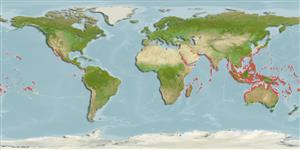Bivalvia |
Lucinida |
Lucinidae
Environment: milieu / climate zone / ระดับความลึก / distribution range
นิเวศวิทยา
; ระดับความลึก 0 - 20 m (อ้างอิง 348). Tropical
Indo-Pacific: from East and South Africa, including Madagascar and the Red Sea, to eastern Polynesia and Hawaii and from southern Australia to northern Japan.
Length at first maturity / ขนาด / Weight / Age
วัยเจริญพันธุ์: Lm ? range ? - ? cm Max length : 9.0 cm SHL เพศผู้/กระเทย; (อ้างอิง 74338); common length : 5.0 cm SHL เพศผู้/กระเทย; (อ้างอิง 348); น้ำหนักสูงสุดที่มีการรายงาน: 210.00 g (อ้างอิง 74338)
Often buried just under the surface of the sandy-muddy substrates near mangrove areas (Ref. 80041). Occurs in mudflats. Abundant shells are present among shell debris in shallow tidal channels within lagoons (Ref. 101158). Deposit-feeder (Ref. 348). Suspension feeder (Ref. 108437).
Life cycle and mating behavior
วัยเจริญพันธุ์ | การสืบพันธุ์ | การวางไข่ | Eggs | ความดกของไข่ | Larvae
Members of the class Bivalvia are mostly gonochoric, some are protandric hermaphrodites. Life cycle: Embryos develop into free-swimming trocophore larvae, succeeded by the bivalve veliger, resembling a miniature clam.
Poutiers, J.M. 1998 Bivalves. Acephala, Lamellibranchia, Pelecypoda. p. 123-362. In Carpenter, K. E. and V. H. Niem. 1998. FAO species identification guide for fishery purposes. The living marine resources of the Western Central Pacific. Volume 1. Seaweeds, corals, bivalves, and gastropods. Rome, FAO. (อ้างอิง 348)
IUCN Red List Status
(อ้างอิง 130435: Version 2025-1)
CITES status (อ้างอิง 108899)
Not Evaluated
CMS (อ้างอิง 116361)
Not Evaluated
Threat to humans
Human uses
การประมง: การค้า
| FishSource |
เครื่องมือ
ข้อมูลเพิ่มเติม
นิเวศวิทยาเขตร้อนFood items (preys)
องค์ประอบของอาหาร
การบริโภคอาหาร
ผู้ล่า
Population dynamicsการเจริญเติบโต
Max. ages / sizes
Length-weight rel.
Length-length rel.
Length-frequencies
Mass conversion
อุดมสมบรูณ์
Life cycleการสืบพันธุ์วัยเจริญพันธุ์ความดกของไข่การวางไข่EggsEgg developmentLarvae Human RelatedStamps, coins, misc.
แหล่งที่มาจากอินเตอร์เน็ต
Estimates based on models
Preferred temperature
(Ref.
115969): 24.1 - 29.3, mean 28.3 (based on 3924 cells).
Fishing Vulnerability
Low vulnerability (10 of 100).
Price category
Unknown.
